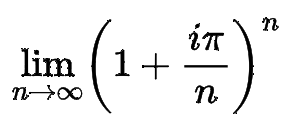While most numbers lead anonymous lives away from the mathematical spotlight, eiπ occupies hallowed ground. Douglas Hofstadter writes that when he first saw the statement eiπ = −1, “. . . perhaps at age 12 or so, it seemed truly magical, almost other-worldly.”
At the risk of deflating the celebrity status of eiπ, what follows is an intuitive, dynamic geometry interpretation described in The Book of Numbers by John Conway and Richard Guy.
Written as a limit, eiπ is equal to the following:
Let’s start small and evaluate (1 + iπ/n)n for n = 8. And rather than use algebra, we can instead approach the computation geometrically: given two complex numbers, z and w, the argument of zw is the sum of the arguments of z and w, and length of zw is the product of the lengths of z and w. (For more information and a proof, see this prior blog post.)
In the sketch below, point B represents (1 + iπ/8) in the complex plane. By measuring ∠AOB (its argument) and OB (its length), we can construct (1 + iπ/8)2, (1 + iπ/8)3, … all the way up to (1 + iπ/8)8 by using desktop Sketchpad’s iteration feature. Point P, whose location is reported as –1.7554 + 0.262i, represents (1 + iπ/8)8.
Now drag slider point n to the right. When n = 130, we see that point P, which represents (1 + iπ/130)130, is equal to –1.0387 + 0.001i. Not bad for a rough approximation of eiπ!
Note that for large n, ∆BOA closely approximates a circle sector with arc length π/n. As there are n stacked triangles in the final product, it makes sense that point P should nearly lie on the negative real axis. The length of OB is (1 + π2/n2)0.5, and so OP is (1 + π2/n2)0.5n. Graphing this expression, entering large n values on a calculator, or using a little calculus suggest OP approaches 1 as n grows infinite. Thus, combining the angle and length observations leads to the conclusion that point P, our eiπ approximation, nears –1 for large n.
